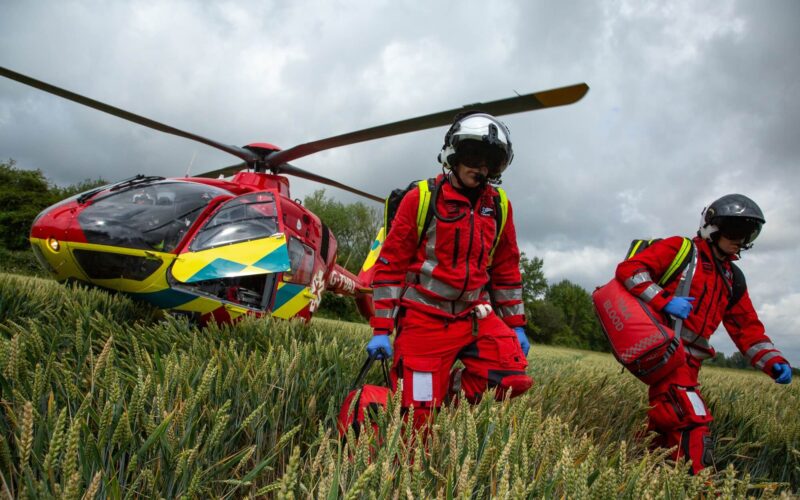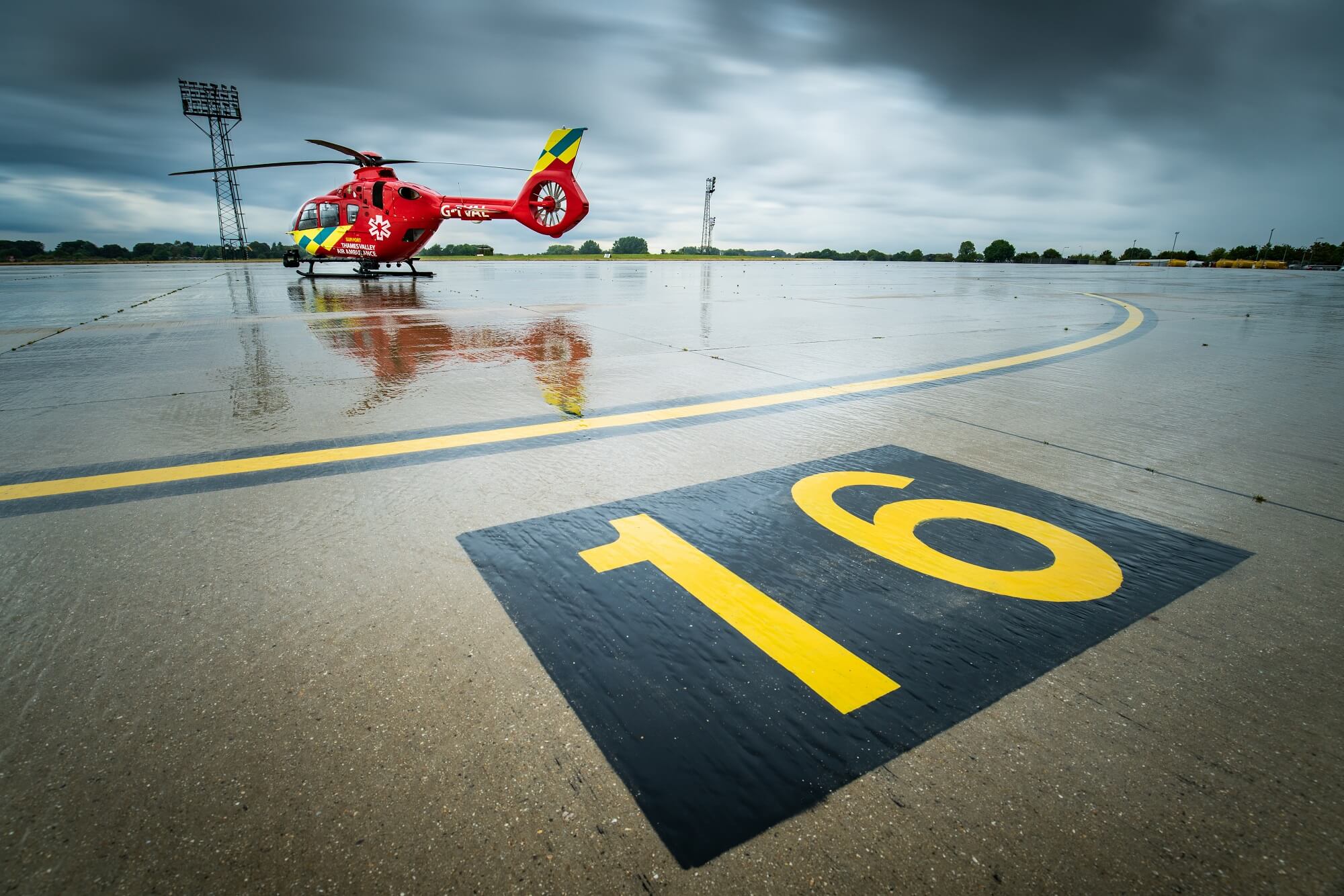The Guard Room at RAF Benson in the Oxfordshire countryside presents the perfect viewpoint to gaze at the Spitfire that adorns the entrance to the airbase. While waiting for security approval to enter the base, I learn that it is home to two front-line Puma HC2 helicopter squadrons and one Operational Conversion Unit, flying a mix of Puma and Chinook helicopters. It is also home to the Operational Evaluation Unit of the Joint Helicopter Command.
However, the airbase also houses another helicopter – G-TVAL. It is the Thames Valley Air Ambulance EC135, that last year performed almost 3,000 missions, transporting specialist equipment and clinical professionals to accidents, medical emergencies, and a range of other dangerous and life-threatening situations.
“We bring the emergency room to the roadside” says Amanda McLean, the chief executive officer of Thames Valley Air Ambulance.
The EC135 performs this critical work transporting the needed medical specialists and their equipment quickly to where it is needed. From the moment they get a callout, the Thames Valley team can scramble and be airborne within six minutes. With a cruising speed of around 120 knots (135MPH), the EC135 can reach anywhere in Berkshire, Oxfordshire and Buckinghamshire within 15 minutes. IThe helicopter often flies from one emergency to another thanks to its 220-mile range (with normal fuel and payload).
Maybe you’ve even seen the helicopter racing overhead. “We normally operate at around 1,000 feet above ground level” explains Ian, the head of flight operations and a former air ambulance pilot. The experienced aviator has a knowledge of the aircraft, operations and the broader aviation industry that keeps me hooked as we walk around the aircraft that is clearly his pride and joy.
“Most people get out of our way and we get a higher priority above all other traffic. When we use the ‘Alpha’ call sign it indicates that we are responding to an emergency,” he explains. “They’ve even shut Heathrow for us a couple of times to allow us to get to a critical case that happened close to the airport.”
G-TVAL carries 200 kilograms (441 pounds) of “role related” equipment, including LUCAS, a CPR device that weighs 12kg. Every item is carefully reviewed and checked a minimum of once per month, with doctors, paramedics, pilots and others all taking on a variety of responsibilities to ensure the smooth and efficient running of the operation.
(Credit: Thames Valley Air Ambulance)
The helicopter weighs “a shade under three tonnes” and it can land in a very small space, says Ian. “We need twice the dimension of the tail to the disc at the front. That’s about 12 metres so we can land in a space of just 24 meters squared, which means that we can always get close and land on a sports field or village green. But safety is always key so if we have to go a little bit further to find a good place to land, we will.”
Being based at RAF Benson has its advantages, explains Chris, the assistant director of operations for Operational Delivery and former RAF Officer. “It’s my job to liaise with the Royal Air Force and other agencies to make sure we all operate in harmony. The RAF is very supportive of what we do here and it’s great to be part of the Base community.”
In September 2022, Thames Valley Air Ambulance is hoping to get its own AOC (Air Operators Certificate) granted by the UK CAA and the current EC135 (leased and serviced by Babcock) will be replaced by a different model aircraft that the charity will buy outright. McLean explains that the new independence this helicopter ownership and AOC will bring means they will be able to react much faster in the interests of patients and crew. “In the future we will be able to make fast decisions about things like night flying and operations around the clock. At the moment we have a number of providers we need to manage these kinds of changes with, but in the future, we will be fully in control of our own operations and our crew will be able to make more operational decisions closer to home.”
I head back into the crew room and find Andy, the critical care paramedic planning the day ahead. “We make sure that we are always ready and that the kit is there, the team is cohesive and that we can go at a moment’s notice. Every shift we do a ground run and make sure everything about the aircraft is operational and it is washed daily.
Planning is crucial, as with other aviation jobs, of course. “We have a full crew briefing which covers all the aviation elements and medical matters, so we all know the situation as we start our shift,” Andy explains “We discuss the weather a lot; that’s very British I guess, but also essential when you’re operating aircraft!”.
The Thames Valley team all cover multiple roles and the paramedics spend one shift a month in the 999 call centre helping the operators to determine when to launch G-TVAL. Critical care paramedic Andy tells me that the shifts in the call centre can be just as challenging as those in the air. “You’re sometimes dealing with six calls at the same time, and you have to work out how to manage it and what resource to send where.”
Modern technology also means that from the call centre, staff can sometimes get a live link to the 999 callers phone camera and see the situation in real-time., Andy reveals “We also have the technology to ascertain a patient’s heart rate and how they are breathing if the caller holds the phone really still near them.”
Andy explains that a good quality phone camera can detect our micro capillaries changing colour which can tell the 999 paramedic team how the heart is beating before any emergency crew reach the site.
Doctor James joins our conversation and explains that there are numerous “crossovers” between medical and aviation. “We have multiple checklists and borrow a lot of good practice from the aviation world. We do constant checklist safety training so that we can’t get it wrong.”
There is a camaraderie in the crew room that most organisations would envy. A real sense of teamwork and a common purpose that leads to ultimate focus on the job in hand – and to giving people the very best chance of survival. Hopefully I will never need the services they provide, but if I do, I have complete faith that I will be in very safe hands.
You can watch the crew of G-TVAL in action on the ‘Emergency Helicopter Medics’ television programme on More4 and catch up TV in the UK.


